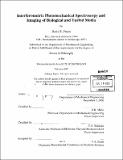Interferometric photomechanical spectroscopy and imaging of biological and turbid media
Author(s)
Payne, Barry
DownloadFull printable version (8.178Mb)
Other Contributors
Massachusetts Institute of Technology. Department of Mechanical Engineering.
Advisor
B.B. Mikic and N.S. Nishioka.
Terms of use
Metadata
Show full item recordAbstract
The medical field is currently experiencing rapid growth in the area of optical diagnostics. Minimally-invasive spectroscopic and imaging modalities enable physicians to make increasingly accurate diagnoses in real time, without the cost and delay associated with traditional reliance on histopathology. We have developed an ultra-high resolution interferometric system which is well suited for clinical diagnostic applications. The interferometric system has a spatial resolution of 0.1 nm and a temporal resolution of 3 ns. We have utilized this high resolution interferometric system in two novel minimally invasive techniques. Both techniques measure surface deformation of a target after absorption of a short laser pulse. The time dependent surface deformation is a function of the target's spatially resolved optical, thermal and mechanical properties. Therefore, accurate measurement of surface displacement can be used to extract significant diagnostic information. The first technique is termed Interferometric Photomechanical Spectroscopy (IPMS), and is used to measure effective optical absorption depth of a sample. We used IPMS to measure effective absorption depth of both diffuse and speculary reflecting targets including well characterized colored glass samples and gelatin based tissue phantoms. (cont.) phantoms. The second technique is termed Interferometric Photomechanical Tomography (IPMT), and is used to image sub-surface absorbers such as tumors or blood vessels. IPMT combines high optical contrast with low attenuation of sound propagation to localize sub-surface absorbers in highly scattering media. We have used IPMT to image sub-surface blood vessels in a phantom model and in vivo. Interferometric techniques compare favorably against diagnostic techniques which measure surface stress instead of surface displacement. This is primarily because interferometry is a non-contact epitaxial method capable of high resolution point measurements. Further, an interferometric system is easily implemented into an optical fiber setup for use in minimally- invasive catheter based procedures.
Description
Thesis (Ph.D.)--Massachusetts Institute of Technology, Dept. of Mechanical Engineering, 2001. "February 2001." Includes bibliographical references (p. 109-118).
Date issued
2001Department
Massachusetts Institute of Technology. Department of Mechanical EngineeringPublisher
Massachusetts Institute of Technology
Keywords
Mechanical Engineering.